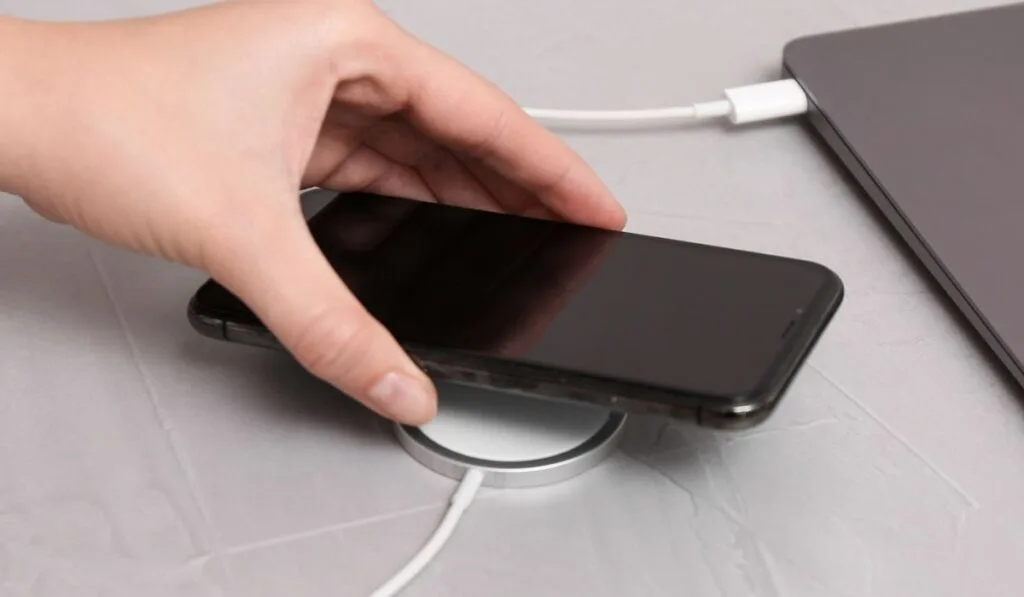Although Qi wireless chargers represent a significant technological advancement, they’re still a work in progress, and they can’t do it all — at least not yet. Did you ever wonder if you can transfer data through a Qi wireless charger?
There are a few Qi wireless chargers that can transfer data by making use of unique bandwidths. You’ll need to install third-party apps to enable this feature, and it only works with the latest smartphones. That said, most Qi wireless chargers don’t support data transfer.
As technology improves, it’s expected that wireless chargers will be able to transfer power and data from a distance of up to 10 meters. Unfortunately, we can’t say when that’ll be the case. In the meantime, let’s take a look at what’s possible with the current wireless charging options.
How Does Qi Communication Work?

Qi communication works by transmitting energy in the form of magnetic waves between a receiver module (Rx) and a transmitter module (Tx). The sender, or charging station, transmits signals to the receiver and your phone, and the two pair with inductive coupling.
Since Qi communication works on a specific frequency, only Qi-compatible phones can receive the signal.
Currently, most Qi chargers are limited in their ability to transfer multiple frequencies simultaneously, which is why you can only charge your phone with a wireless charger. With the frequency transmission and capture limitations, most Qi wireless cannot transfer data.
However, the structure of Qi communication makes it possible for chargers to be developed with an optical and data module.
One module will be able to transmit wavelengths at narrow bandwidths for power transfers, while the other module transmits a wider bandwidth for data transfer. However, current Qi communication systems can’t transmit signals of various bandwidths from a single point, which is why most wireless chargers are limited to charging.
Can You Transfer Files With a Wireless Charger?
You can transfer files with some of the latest wireless chargers. However, the file transfer feature is limited since wireless chargers that offer this feature are still prototypes. Some wireless chargers can charge your phone while serving as a backup for wireless file transfer, but even these have limited applications.
Apple already patented a design for a wireless charger with data transfer in 2016 but the company hasn’t yet released it. Apple’s wireless charger prototype has the ability to transfer data and power using two optical modules from the charger. However, they haven’t released it on a wide scale, and they still have to develop the prototype.
SanDisk has also released a wireless charger (on Amazon) that can backup data and files wirelessly. SanDisk’s wireless charger is quite advanced and works with the latest Samsung and Apple phones and some other smartphone brands that are Qi-compatible. The charger also functions as a hard drive and can store data even when the smartphone isn’t connected.
How Do You Transfer Data Through Wireless Chargers?

Unlike charging your phone, transferring data through a wireless charger requires a third-party application that most smartphones don’t have. However, you can purchase and install software that will enable data transfer through wireless chargers.
Follow these steps to enable data transfer through a wireless charger:
- Download the FTP server from the App Store or Play Store. This server will read incoming signals from other devices and allows you to connect to wireless chargers that have a data transfer option.
- Set up the FTP server. Make sure the port is set to 8000 and the ‘Launch Android at startup‘ and ‘Restrict to default directory‘ options are unchecked.
- Download the Tasker app. This is a paid app, so you’ll have to either purchase it or sign up for a free trial.
- On the Tasker app, go onto power options and select ‘Wireless.’ You can also select the ‘AC‘ and ‘USB‘ options. In the wireless power option, name the task ‘FTP.’
- Click on the + icon to add an action category and select ‘App.’
- Click on ‘Launch app‘ and select ‘FTP Server.’
- Download an FTP client on your desktop. You can use Filezilla or WinSCP.
- Fill in the same username, password, and port details as on your smartphone app.
- Click on the ‘Setup site‘ icon, and you’ll connect to your mobile. When the mobile is connected to the wireless charger, you’ll be able to transfer files freely between the two devices.
While this process is quite complicated, it’s the only option you have with most wireless chargers. That said, some chargers, like the SanDisk charger, can connect directly to many of the latest smartphones.
As wireless chargers evolve, it’s expected that they will become more sophisticated, and data transfer will be enabled from a distance without the need for third-party applications.
